Timing and Tectonic Implications of the Development of the Orosirian Qianlishan Ductile Shear Zones in the Khondalite Belt, North China Craton
Abstract
:1. Introduction
2. Geological Setting
3. Samples and Methods
4. Results
4.1. Structural Observations
4.2. Zircon U-Pb Geochronology
4.2.1. Pre-Kinematic Granitoid Pluton (Sample 20QL02)
4.2.2. Mylonitic Granitoid Pluton (Sample 22QL03)
4.2.3. Mylonitic Granitic Dyke (Sample 22QL13)
4.2.4. Felsic Mylonite (Sample 22QL11)
5. Discussion
5.1. Timing of the Development of the Qianlishan Ductile Shear Zones (QDSZ)
5.2. Three Phases of Orosirian Deformation (D1–D3) in the Qianlishan Complex
5.3. Implications for the Deformation History of the Khondalite Belt
6. Conclusions
Supplementary Materials
Author Contributions
Funding
Data Availability Statement
Acknowledgments
Conflicts of Interest
References
- Ramsay, J.G.; Graham, R.H. Strain variation in shear belts. Can. J. Earth Sci. 1970, 7, 786–813. [Google Scholar] [CrossRef]
- Sibson, R.H. Fault rocks and fault mechanisms. J. Geol. Soc. 1977, 133, 191–213. [Google Scholar] [CrossRef]
- Ramsay, J. Shear zone geometry: A review. J. Struct. Geol. 1980, 2, 83–99. [Google Scholar] [CrossRef]
- Fossen, H.; Cavalcante, G.C.G. Shear zones—A review. Earth-Sci. Rev. 2017, 171, 434–455. [Google Scholar] [CrossRef]
- Zhang, H.; Hou, G.; Zhang, B.; Tian, W. Kinematics, temperature and geochronology of the Qingyi ductile shear zone: Tectonic implications for late Neoarchean microblock amalgamation in the Western Shandong Province, North China craton. J. Struct. Geol. 2022, 161, 104645. [Google Scholar] [CrossRef]
- Li, W.; Cao, S.; Dong, Y.; Zhan, L.; Tao, L. Crustal anatexis and initiation of the continental-scale Chongshan strike-slip shear zone on the southeastern Tibetan Plateau. Tectonics 2023, 42, e2023TC007864. [Google Scholar] [CrossRef]
- Cao, S.; Neubauer, F. Deep crustal expressions of exhumed strike-slip fault systems: Shear zone initiation on rheological boundaries. Earth-Sci. Rev. 2016, 162, 155–176. [Google Scholar] [CrossRef]
- Oriolo, S.; Wemmer, K.; Oyhantçabal, P.; Fossen, H.; Schulz, B.; Siegesmund, S. Geochronology of shear zones—A review. Earth-Sci. Rev. 2018, 185, 665–683. [Google Scholar] [CrossRef]
- Qiu, E.; Zhang, Y.; Larson, K.P.; Li, B. Dating strike-slip ductile shear through combined zircon-, titanite-and apatite U–Pb geochronology along the southern Tan-Lu Fault zone, East China. Tectonics 2023, 42, e2022TC007734. [Google Scholar] [CrossRef]
- Stipp, M.; StuÈnitz, H.; Heilbronner, R.; Schmid, S.M. The eastern Tonale fault: A ‘natural laboratory’ for crystal plastic deformation of quartz over a temperature range from 250 to 700 °C. J. Struct. Geol. 2002, 24, 1861–1884. [Google Scholar] [CrossRef]
- Passchier, C.W.; Trouw, R. Microtectonics; Springer: Berlin/Heidelberg, Germany, 2005. [Google Scholar]
- Ribeiro, B.V.; Kirkland, C.L.; Kelsey, D.E.; Reddy, S.M.; Hartnady, M.I.; Faleiros, F.M.; Rankenburg, K.; Liebmann, J.; Korhonen, F.J.; Clark, C. Time-strain evolution of shear zones from petrographically constrained Rb–Sr muscovite analysis. Earth Planet. Sci. Lett. 2023, 602, 117969. [Google Scholar] [CrossRef]
- Sun, S.; Dong, Y. High temperature ductile deformation, lithological and geochemical differentiation along the Shagou shear zone, Qinling Orogen, China. J. Struct. Geol. 2023, 167, 104791. [Google Scholar] [CrossRef]
- van der Pluijm, V.A.; Mezger, K.; Cosca, M.A.; Essene, E.J. Determining the significance of high-grade shear zones by using temperature-time paths, with examples from the Grenville orogen. Geology 1994, 22, 743–746. [Google Scholar] [CrossRef]
- Reiners, P.W.; Ehlers, T.A.; Zeitler, P.K. Past, present, and future of thermochronology. Rev. Mineral. Geochem. 2005, 58, 1–18. [Google Scholar] [CrossRef]
- Law, R.D. Deformation thermometry based on quartz c-axis fabrics and recrystallization microstructures: A review. J. Struct. Geol. 2014, 66, 129–161. [Google Scholar] [CrossRef]
- Simonetti, M.; Carosi, R.; Montomoli, C.; Law, R.D.; Cottle, J.M. Unravelling the development of regional-scale shear zones by a multidisciplinary approach: The case study of the Ferrière-Mollières Shear Zone (Argentera Massif, Western Alps). J. Struct. Geol. 2021, 149, 104399. [Google Scholar] [CrossRef]
- Zhao, G.; Sun, M.; Wilde, S.A.; Li, S. Late Archean to Paleoproterozoic evolution of the North China Craton: Key issues revisited. Precambrian Res. 2005, 136, 177–202. [Google Scholar] [CrossRef]
- Zhao, G.; Cawood, P.A.; Li, S.; Wilde, S.A.; Sun, M.; Zhang, J.; He, Y.; Yin, C. Amalgamation of the North China Craton: Key issues and discussion. Precambrian Res. 2012, 222, 55–76. [Google Scholar] [CrossRef]
- Yin, C.; Zhao, G.; Sun, M.; Xia, X.; Wei, C.; Zhou, X.; Leung, W. LA-ICP-MS U–Pb zircon ages of the Qianlishan Complex: Constrains on the evolution of the Khondalite Belt in the Western Block of the North China Craton. Precambrian Res. 2009, 174, 78–94. [Google Scholar] [CrossRef]
- Yin, C.; Qiao, H.; Lin, S.; Li, C.; Zhang, J.; Qian, J.; Wu, S. Deformation history of the Qianlishan complex, Khondalite belt, North China: Structures, ages and tectonic implications. J. Struct. Geol. 2020, 141, 104176. [Google Scholar] [CrossRef]
- Yin, C.; Zhao, G.; Xiao, W.; Lin, S.; Gao, R.; Zhang, J.; Qian, J.; Gao, P.; Qiao, H.; Li, W. Paleoproterozoic accretion and assembly of the Western Block of North China: A new model. Earth-Sci. Rev. 2023, 241, 104448. [Google Scholar] [CrossRef]
- Guo, J.; Peng, P.; Chen, Y.; Jiao, S.; Windley, B.F. UHT sapphirine granulite metamorphism at 1.93–1.92 Ga caused by gabbronorite intrusions: Implications for tectonic evolution of the northern margin of the North China Craton. Precambrian Res. 2012, 222, 124–142. [Google Scholar] [CrossRef]
- Lu, L.; Xu, X.; Liu, F. Early Precambrian Khondalites in North China: Changchun; Changchun Publishing House: Changchun, China, 1996. [Google Scholar]
- Guo, J.; Zhai, M. Mylonite of granulite facies in Xuwujia, Nei Monggol. Chin. J. Geol. 1992, 27, 190–192, (In Chinese with English Abstract). [Google Scholar]
- Gan, S.; Qian, X. A plate-tectonic model for the evolution of the Daqingshan granulite belt in Inner Mongolia, China. Acta Geol. Sin. 1996, 70, 298–308, (In Chinese with English Abstract). [Google Scholar] [CrossRef]
- Gong, W.; Hu, J.; Wu, S.; Chen, H.; Qu, H.; Li, Z.; Liu, Y.; Wang, L. Possible southwestward extrusion of the Ordos Block in the Late Paleoproterozoic: Constraints from kinematic and geochronologic analysis of peripheral ductile shear zones. Precambrian Res. 2014, 255, 716–733. [Google Scholar] [CrossRef]
- Qiao, H.; Yin, C.; Xiao, W.; Zhang, J.; Qian, J.; Wu, S. Paleoproterozoic polyphase deformation in the Helanshan Complex: Structural and geochronological constraints on the tectonic evolution of the Khondalite Belt, North China Craton. Precambrian Res. 2022, 368, 106468. [Google Scholar] [CrossRef]
- Zhao, G.; Zhai, M. Lithotectonic elements of Precambrian basement in the North China Craton: Review and tectonic implications. Gondwana Res. 2013, 23, 1207–1240. [Google Scholar] [CrossRef]
- Kusky, T.M.; Polat, A.; Windley, B.F.; Burke, K.C.; Dewey, J.F.; Kidd, W.S.F.; Maruyama, S.; Wang, J.; Deng, H.; Wang, Z.; et al. Insights into the tectonic evolution of the North China Craton through comparative tectonic analysis: A record of outward growth of Precambrian continents. Earth-Sci. Rev. 2016, 162, 387–432. [Google Scholar] [CrossRef]
- Wei, C.; Zhai, M.; Wang, B. Four phases of Orosirian metamorphism in the north North China Craton (NNCC): Insights into the regional tectonic framework and evolution. Earth-Sci. Rev. 2023, 241, 104449. [Google Scholar] [CrossRef]
- Yin, C.; Zhao, G.; Guo, J.; Sun, M.; Xia, X.; Zhou, X.; Liu, C. U–Pb and Hf isotopic study of zircons of the Helanshan Complex: Constrains on the evolution of the Khondalite Belt in the Western Block of the North China Craton. Lithos 2011, 122, 25–38. [Google Scholar] [CrossRef]
- Liu, P.; Liu, F.; Liu, C.; Liu, J.; Wang, F.; Xiao, L.; Cai, J.; Shi, J. Multiple mafic magmatic and high-grade metamorphic events revealed by zircons from meta-mafic rocks in the Daqingshan–Wulashan Complex of the Khondalite Belt, North China Craton. Precambrian Res. 2014, 246, 334–357. [Google Scholar] [CrossRef]
- Liu, P.; Liu, F.; Cai, J.; Liu, C.; Liu, J.; Wang, F.; Xiao, L.; Shi, J. Spatial distribution, P–T–t paths, and tectonic significance of high-pressure mafic granulites from the Daqingshan–Wulashan Complex in the Khondalite Belt, North China Craton. Precambrian Res. 2017, 303, 687–708. [Google Scholar] [CrossRef]
- Cai, J.; Liu, F.; Liu, P. Paleoproterozoic multistage metamorphic events in Jining metapelitic rocks from the Khondalite Belt in the North China Craton: Evidence from petrology, phase equilibria modelling and U–Pb geochronology. J. Asian Earth Sci. 2017, 138, 515–534. [Google Scholar] [CrossRef]
- Jiao, S.; Fitzsimons, I.C.; Zi, J.; Evans, N.J.; Mcdonald, B.J.; Guo, J. Texturally controlled U–Th–Pb monazite geochronology reveals Paleoproterozoic UHT metamorphic evolution in the Khondalite belt, North China craton. J. Petrol. 2020, 61, egaa023. [Google Scholar] [CrossRef]
- Wu, S.; Yin, C.; Davis, D.W.; Zhang, J.; Qian, J.; Qiao, H.; Xiao, Y.; Liu, J. Metamorphic evolution of high-pressure felsic and pelitic granulites from the Qianlishan Complex and tectonic implications for the Khondalite Belt, North China Craton. Geol. Soc. Am. Bull. 2020, 132, 2253–2266. [Google Scholar] [CrossRef]
- Jiang, X.; Yu, S.; Liu, Y.; Li, S.; Lv, P.; Peng, Y.; Gao, X.; Ji, W.; Li, C.; Xie, W. Episodic metamorphism and anatexis within the Khondalite Belt, North China Craton: Constraint from Late-Paleoproterozoic fluid-fluxed melting of the Daqingshan Complex. Precambrian Res. 2022, 369, 106504. [Google Scholar] [CrossRef]
- Qiao, H.; Deng, P.; Li, J. Geochronological Constraints on the Origin of the Paleoproterozoic Qianlishan Gneiss Domes in the Khondalite Belt of the North China Craton and Their Tectonic implications. Minerals 2023, 13, 1361. [Google Scholar] [CrossRef]
- Shi, Q.; Xu, Z.; Santosh, M.; Ding, D.; Zhao, Z.; Li, C.; Gao, X.; Ma, W.; Xu, Y.; Li, H.; et al. Mantle Magmatism, Metamorphism and Anatexis: Evidence from Geochemistry and Zircon U–Pb-Hf Isotopes of Paleoproterozoic S-type Granites, Khondalite Belt of the North China Craton. Int. Geol. Rev. 2023, 65, 943–968. [Google Scholar] [CrossRef]
- Zhu, W.; Tian, W.; Wang, B.; Zhang, Y.; Wei, C. Paleoproterozoic Crust–Mantle Interaction in the Khondalite Belt, North China Craton: Constraints from Geochronology, Elements, and Hf-O-Sr-Nd Isotopes of the Layered Complex in the Jining Terrane. Minerals 2023, 13, 462. [Google Scholar] [CrossRef]
- Zhai, M. Khondalite revisited-record of special geological processes on Earth. Acta Petrol. Sin. 2022, 96, 2967–2997, (In Chinese with English Abstract). [Google Scholar] [CrossRef]
- Xia, X.; Sun, M.; Zhao, G.; Luo, Y. LA-ICP-MS U–Pb geochronology of detrital zircons from the Jining Complex, North China Craton and its tectonic significance. Precambrian Res. 2006, 144, 199–212. [Google Scholar] [CrossRef]
- Xia, X.; Sun, M.; Zhao, G.; Wu, F.; Xu, P.; Zhang, J.; Luo, Y. U–Pb and Hf isotopic study of detrital zircons from the Wulashan khondalites: Constraints on the evolution of the Ordos Terrane, Western Block of the North China Craton. Earth Planet. Sci. Lett. 2006, 241, 581–593. [Google Scholar] [CrossRef]
- Wan, Y.; Song, B.; Liu, D.; Wilde, S.A.; Wu, J.; Shi, Y.; Yin, X.; Zhou, H. SHRIMP U–Pb zircon geochronology of Palaeoproterozoic metasedimentary rocks in the North China Craton: Evidence for a major Late Palaeoproterozoic tectonothermal event. Precambrian Res. 2006, 149, 249–271. [Google Scholar] [CrossRef]
- Wan, Y.; Liu, D.; Dong, C.; Xu, Z.; Wang, Z.; Wilde, S.A.; Yang, Y.; Liu, Z.; Zhou, H. The Precambrian Khondalite Belt in the Daqingshan area, North China Craton: Evidence for multiple metamorphic events in the Palaeoproterozoic era. Geol. Soc. London, Spec. Publ. 2009, 323, 73–97. [Google Scholar] [CrossRef]
- Wan, Y.; Xu, Z.; Dong, C.; Nutman, A.; Ma, M.; Xie, H.; Liu, S.; Liu, D.; Wang, H.; Cu, H. Episodic Paleoproterozoic (~2.45, ~1.95 and ~1.85 Ga) mafic magmatism and associated high temperature metamorphism in the Daqingshan area, North China Craton: SHRIMP zircon U–Pb dating and whole-rock geochemistry. Precambrian Res. 2013, 224, 71–93. [Google Scholar] [CrossRef]
- Dong, C.; Liu, D.; Li, J.; Wang, Y.; Zhou, H.; Li, C.; Yang, Y.; Xie, L. Palaeoproterozoic Khondalite Belt in the western North China Craton: New evidence from SHRIMP dating and Hf isotope composition of zircons from metamorphic rocks in the Bayan Ul-Helan Mountains area. Chin. Sci. Bull. 2007, 52, 2984–2994, (In Chinese with English Abstract). [Google Scholar] [CrossRef]
- Zhou, X.; Geng, Y. Metamorphic age of the khondalites in the Helanshan region: Constraints on the evolution of the Western block in the North China Craton. Acta Petrol. Sin. 2009, 25, 1843–1852, (In Chinese with English Abstract). [Google Scholar]
- Jiao, S.; Guo, J.; Harley, S.L.; Peng, P. Geochronology and trace element geochemistry of zircon, monazite and garnet from the garnetite and/or associated other high-grade rocks: Implications for Palaeoproterozoic tectonothermal evolution of the Khondalite Belt, North China Craton. Precambrian Res. 2013, 237, 78–100. [Google Scholar] [CrossRef]
- Jiao, S.; Guo, J.; Wang, L.; Peng, P. Short-lived high-temperature prograde and retrograde metamorphism in Shaerqin sapphirine-bearing metapelites from the Daqingshan terrane, North China Craton. Precambrian Res. 2015, 269, 31–57. [Google Scholar] [CrossRef]
- Jiao, S.; Fitzsimons, I.C.; Guo, J. Paleoproterozoic UHT metamorphism in the Daqingshan Terrane, North China Craton: New constraints from phase equilibria modeling and SIMS U–Pb zircon dating. Precambrian Res. 2017, 303, 208–227. [Google Scholar] [CrossRef]
- Santosh, M.; Liu, D.; Shi, Y.; Liu, S. Paleoproterozoic accretionary orogenesis in the North China Craton: A SHRIMP zircon study. Precambrian Res. 2013, 227, 29–54. [Google Scholar] [CrossRef]
- Liu, S.; Dong, C.; Xu, Z.; Santosh, M.; Ma, M.; Xie, H.; Liu, D.; Wang, Y. Palaeoproterozoic episodic magmatism and high-grade metamorphism in the North China Craton: Evidence from SHRIMP zircon dating of magmatic suites in the Daqingshan area. Geol. J. 2013, 48, 429–455. [Google Scholar] [CrossRef]
- He, X.; Yin, C.; Long, X.; Qian, J.; Wang, L.; Qiao, H. Archean to Paleoproterozoic continental crust growth in the Western Block of North China: Constraints from zircon Hf isotopic and whole-rock Nd isotopic data. Precambrian Res. 2017, 303, 105–116. [Google Scholar] [CrossRef]
- Wang, L.; Guo, J.; Yin, C.; Peng, P. Petrogenesis of ca. 1.95 Ga meta-leucogranites from the Jining Complex in the Khondalite Belt, North China Craton: Water-fluxed melting of metasedimentary rocks. Precambrian Res. 2017, 303, 355–371. [Google Scholar] [CrossRef]
- Gou, L.; Zi, J.; Dong, Y.; Liu, X.; Li, Z.; Xu, X.; Zhang, C.; Liu, L.; Long, X.; Zhao, Y. Timing of two separate granulite-facies metamorphic events in the Helanshan complex, North China Craton: Constraints from monazite and zircon U–Pb dating of pelitic granulites. Lithos 2019, 350, 105216. [Google Scholar] [CrossRef]
- Zhou, X.; Zhao, G.; Geng, Y. Helanshan high-pressure pelitic granulites: Petrological evidence for collision event in the Western Block of the North China Craton. Acta Petrol. Sin. 2010, 26, 2113–2121, (In Chinese with English Abstract). [Google Scholar] [CrossRef]
- Cai, J.; Liu, F.; Liu, P.; Liu, C.; Wang, F.; Shi, J. Metamorphic P–T path and tectonic implications of pelitic granulites from the Daqingshan Complex of the Khondalite Belt, North China Craton. Precambrian Res. 2014, 241, 161–184. [Google Scholar] [CrossRef]
- Yin, C.; Zhao, G.; Wei, C.; Sun, M.; Guo, J.; Zhou, X. Metamorphism and partial melting of high-pressure pelitic granulites from the Qianlishan Complex: Constraints on the tectonic evolution of the Khondalite Belt in the North China Craton. Precambrian Res. 2014, 242, 172–186. [Google Scholar] [CrossRef]
- Yin, C.; Zhao, G.; Sun, M. High-pressure pelitic granulites from the Helanshan Complex in the Khondalite Belt, North China Craton: Metamorphic P-T path and tectonic implications. Am. J. Sci. 2015, 315, 846–879. [Google Scholar] [CrossRef]
- Xu, X.; Gou, L.; Long, X.; Dong, Y.; Liu, X.; Zi, J.; Li, Z.; Zhang, C.; Liu, L.; Zhao, J. Phase equilibrium modelling and SHRIMP zircon U–Pb dating of medium-pressure pelitic granulites in the Helanshan complex of the Khondalite Belt, North China Craton, and their tectonic implications. Precambrian Res. 2018, 314, 62–75. [Google Scholar] [CrossRef]
- Xu, X.; Gou, L.; Dong, Y.; Zhang, C.; Long, X.; Zhao, Y.; Zhou, F.; Tian, Z. Metamorphic P–T evolution of the pelitic granulites from the Helanshan in the North China Craton revealed by phase equilibrium modeling and garnet trace elements: Implications for Paleoproterozoic collisional orogenesis. Precambrian Res. 2013, 394, 107093. [Google Scholar] [CrossRef]
- Wang, H.; Yuan, G.; Xing, H.; Wang, J. One the tectonic implication for Xiashihao-Jiuguan ductile shear zone in Guyang-Wuchuan area, Inner Mongolia. Prog. Precambrian Res. 1999, 22, 1–20, (In Chinese with English Abstract). [Google Scholar]
- Qiao, H.; Yin, C.; Zhang, J.; Qian, J.; Wu, S. New Discovery of~1866 Ma high-temperature mylonite in the Helanshan Complex: Marking a late-stage Ductile Shearing in the Khondalite Belt, North China Craton. Acta Geol. Sin. Engl. Ed. 2021, 95, 1418–1419. [Google Scholar] [CrossRef]
- Qiao, H.Z. Detrital zircon U–Pb ages of the Huangqikou Formation of the Changcheng System in the Qianlishan Area, western North China Craton and their geological implications. Acta Geol. Sichuan 2021, 41, 33–39, (In Chinese with English Abstract). [Google Scholar]
- Qiao, H.; Yin, C.; Li, Q.; He, X.; Qian, J.; Li, W. Application of the revised Ti-in-zircon thermometer and SIMS zircon U-Pb dating of high-pressure pelitic granulites from the Qianlishan-Helanshan Complex of the Khondalite Belt, North China Craton. Precambrian Res. 2016, 276, 1–13. [Google Scholar] [CrossRef]
- Li, W.; Yin, C.; Lin, S.; Li, W.; Gao, P.; Zhang, J.; Qian, J.; Qiao, H. Paleoproterozoic tectonic evolution from subduction to collision of the Khondalite Belt in North China: Evidence from multiple magmatism in the Qianlishan Complex. Precambrian Res. 2022, 368, 106471. [Google Scholar] [CrossRef]
- Qiao, H. Structural and Geochronological Studies of the Qianlishan-Helanshan Complex in North China. Ph. D. Thesis, Sun Yat-sen University, Guangzhou, China, 2019. (In Chinese with English Abstract). [Google Scholar]
- Lu, C.; Qian, J.; Yin, C.; Gao, P.; Guo, M.; Zhang, W. Ultrahigh temperature metamorphism recorded in the Lüliang Complex, Trans-North China Orogen: P–T–t evolution and heating mechanism. Precambrian Res. 2022, 383, 106900. [Google Scholar] [CrossRef]
- Liu, Y.; Hu, Z.; Gao, S.; Günther, D.; Xu, J.; Gao, C.; Chen, H. In situ analysis of major and trace elements of anhydrous minerals by LA-ICP-MS without applying an internal standard. Chem. Geol. 2008, 257, 34–43. [Google Scholar] [CrossRef]
- Ludwig, K.R. Isoplot/Ex Version 4.15: A Geochronological Toolkit for Microsoft Excel; Berkeley Geochronology Center Special Publication: Berkeley, CA, USA, 2012; Volume 5, p. 75. [Google Scholar]
- Hippertt, J.; Rocha, A.; Lana, C.; Egydio-Silva, M.; Takeshita, T. Quartz plastic segregation and ribbon development in high-grade striped gneisses. J. Struct. Geol. 2001, 23, 67–80. [Google Scholar] [CrossRef]
- Yan, Y. A study on P-T condition and mineralogy of the metamorphic complex of the Qianlishan Group, Nei Mongol. In Petrology Research (Second Collection); Institute of Geology, Chinese Academy of Science, Ed.; Geological Publishing House: Beijing, China, 1983; (In Chinese with English Abstract). [Google Scholar]
- Shen, Q.; Fu, Y.; Zhang, M. 40Ar/39Ar dating on biotite from the Qianlishan Group in Bohai Bay, Nei Monggol. Bull. Inst. Geol. Chin. Acad. Geol. Sci. 1988, 18, 68–74, (In Chinese with English Abstract). [Google Scholar]
- Ma, M.; Wan, Y.; Xu, Z.; Liu, S.; Xie, H.; Dong, C.; Liu, D. Late Paleoproterozoic K-feldspar pegmatite veins in Daqingshan area, North China Craton: SHRIMP age and Hf composition of zircons. Geol. Bull. China 2012, 31, 825–833, (In Chinese with English Abstract). [Google Scholar]
- Liu, T.; Li, W.; Liu, Y.; Jin, W.; Zhao, Y.; Iqbal, M.Z. Deformation characteristics of the high-grade metamorphic and anatectic rocks in the Daqingshan Paleoproterozoic orogenic belt, Inner Mongolia: A case study from the Shijiaqu-Xuehaigou area. Precambrian Res. 2022, 374, 106644. [Google Scholar] [CrossRef]
- Li, X.; Yang, Z.; Zhao, G.; Grapes, R.; Guo, J. Geochronology of khondalite-series rocks of the Jining Complex: Confirmation of depositional age and tectonometamorphic evolution of the North China craton. Int. Geol. Rev. 2011, 53, 1194–1211. [Google Scholar] [CrossRef]


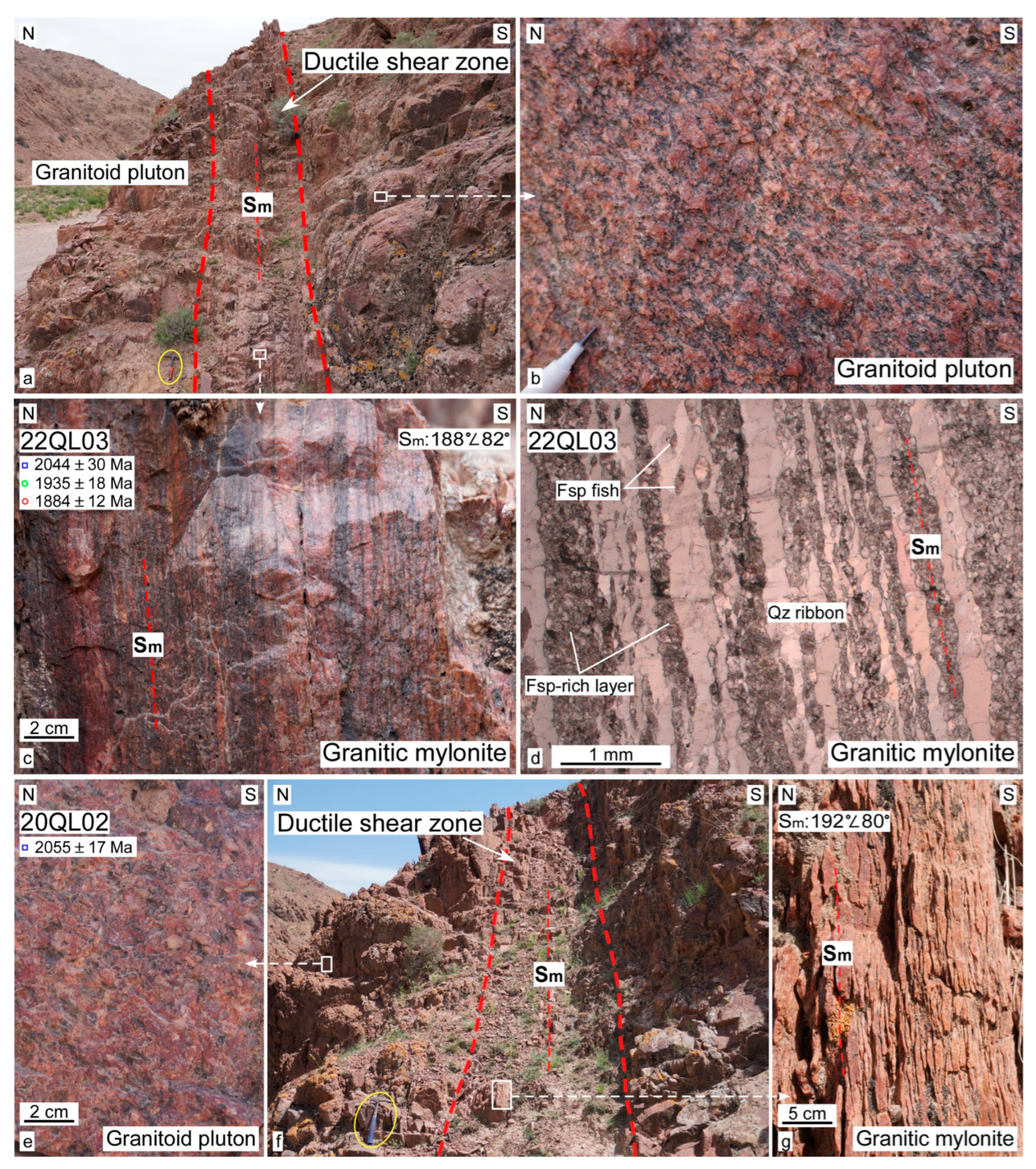
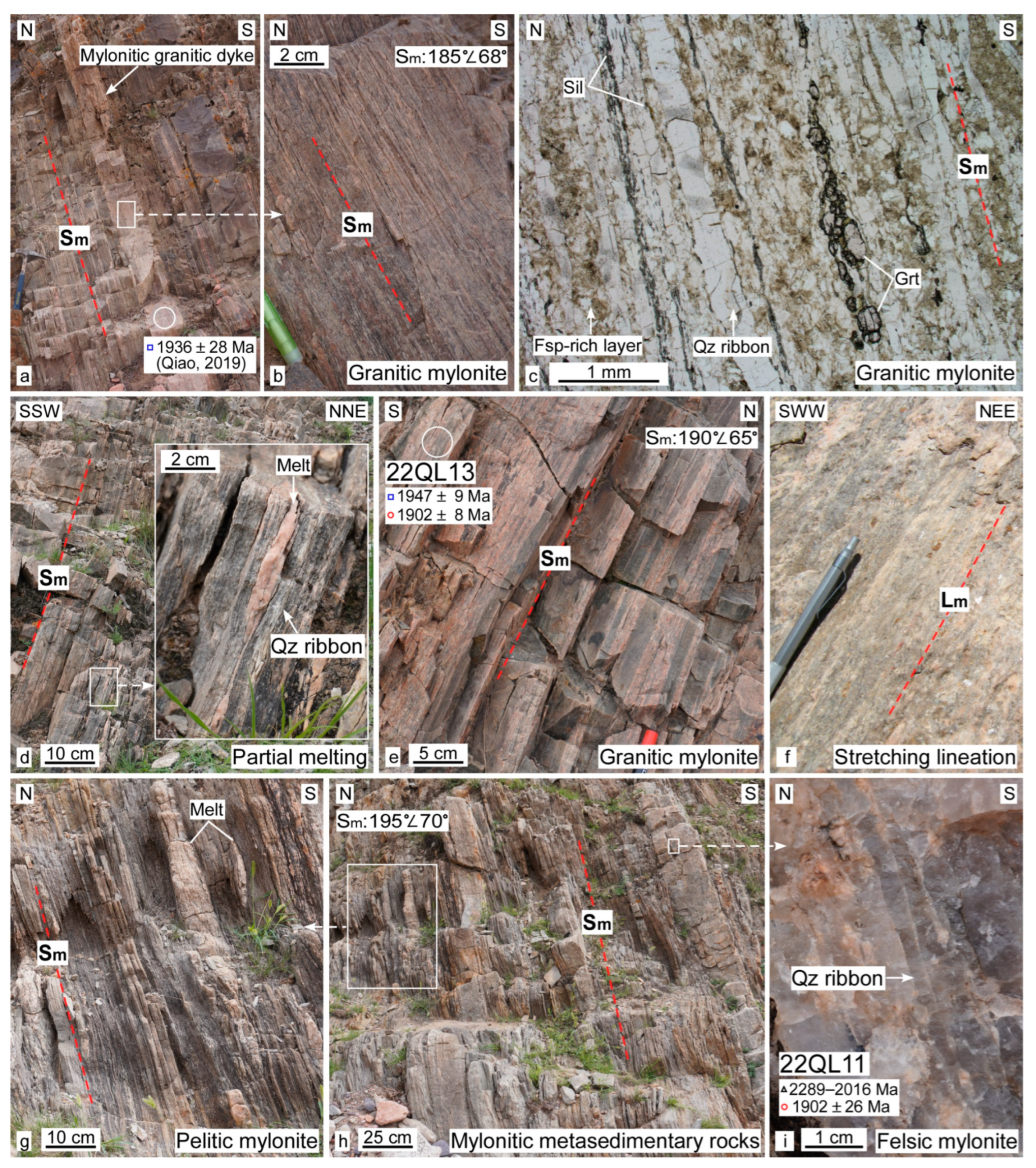

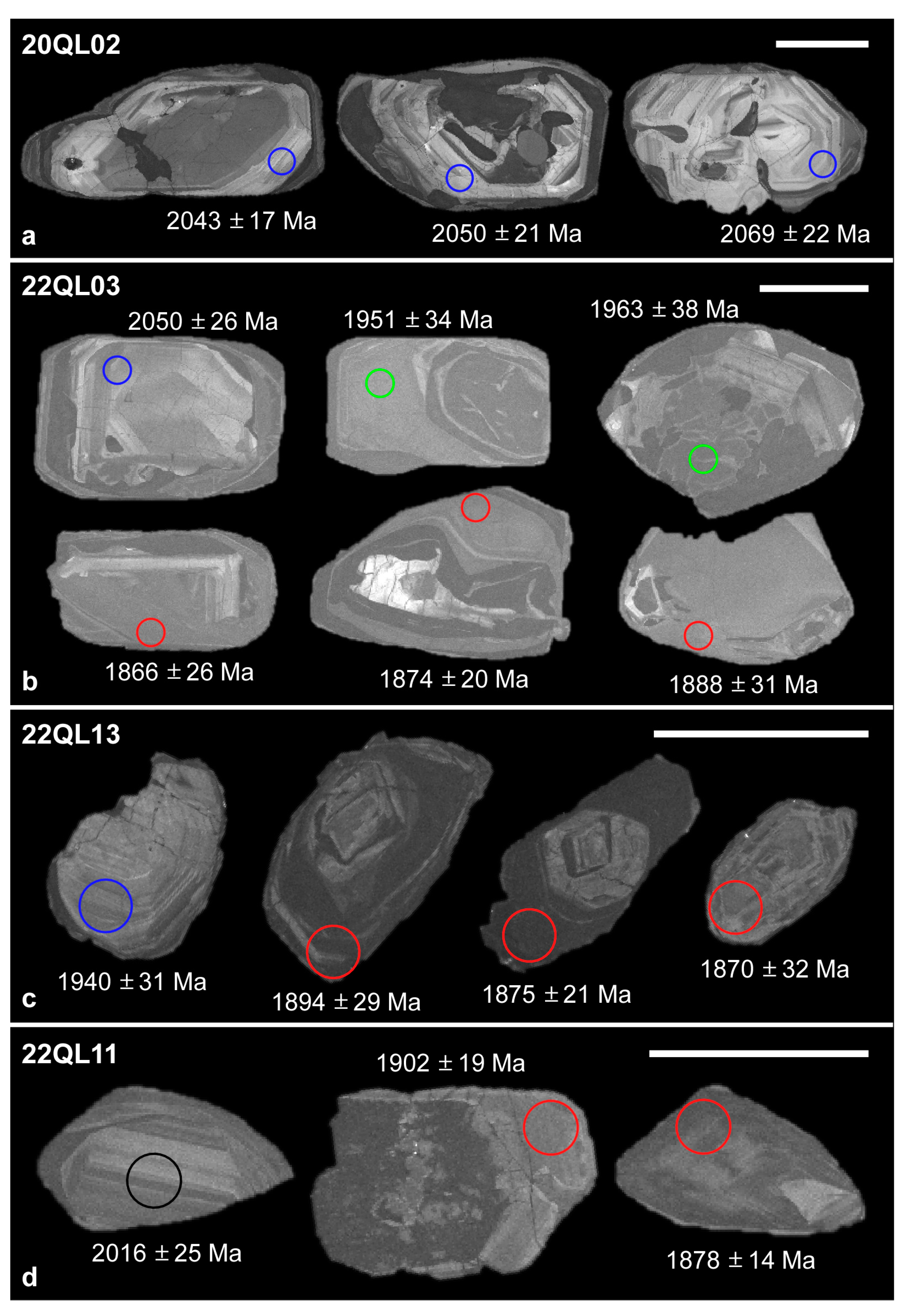
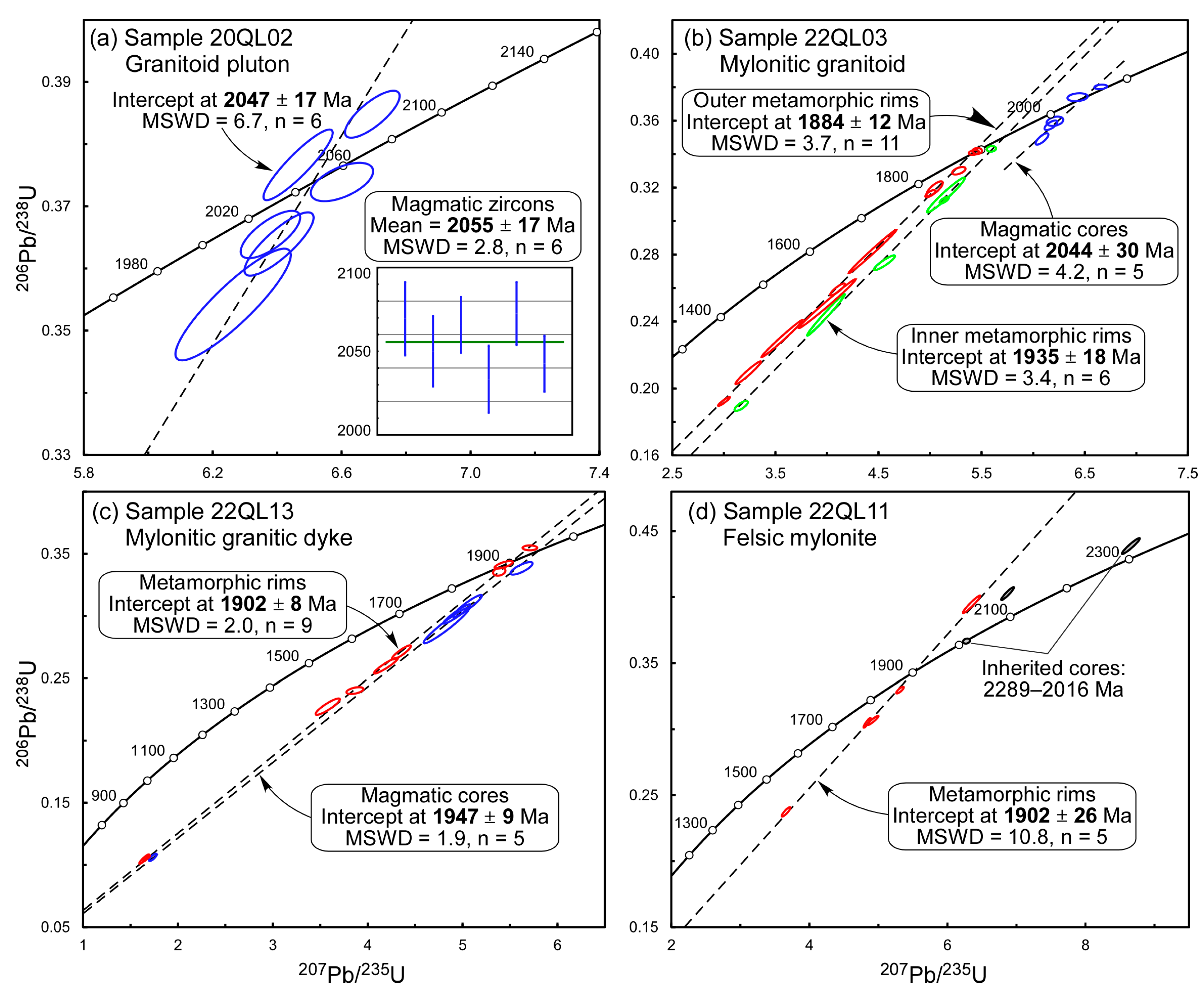

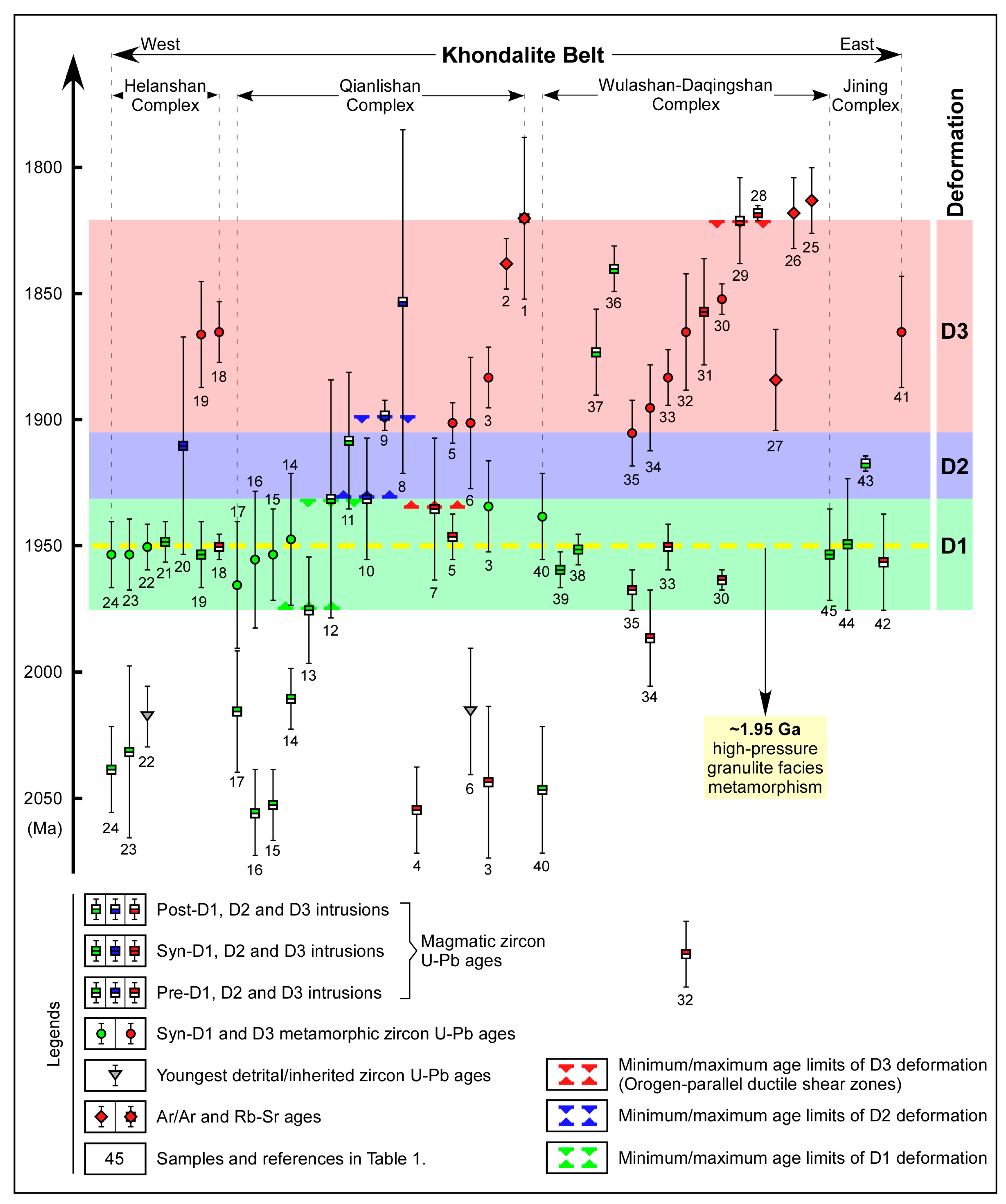
| No. 1 | Sample | Rock Type and Structural Feature | Age (Ma) | Type 2 | n | MSWD | Interpretation | References |
|---|---|---|---|---|---|---|---|---|
| Qianlishan Complex | ||||||||
| 1 | - | Deformed metapelite | 1821 ± 32 | MIA | - | - | D3-related process | [74] |
| 2 | N80-48 | Deformed metapelite | 1839 ± 10 | Bt/PA | - | - | D3-related process | [75] |
| 3 | 22QL03 | Granitic mylonite | 1884 ± 12 | M/UI | 11 | 3.7 | Syn-D3 metamorphism | This study |
| 1935 ± 18 | M/UI | 6 | 3.4 | Syn-D1 metamorphism | ||||
| 2044 ± 30 | I/UI | 5 | 4.2 | Pre-D3 intrusion | ||||
| 4 | 20QL02 | Granitoid cut by DSZ * | 2055 ± 17 | I/WM | 6 | 2.8 | Pre-D3 intrusion | This study |
| 5 | 22QL13 | Mylonitized granitic dyke | 1902 ± 8 | M/UI | 9 | 2.0 | Syn-D3 metamorphism | This study |
| 1947 ± 9 | I/UI | 5 | 1.9 | Pre-D3 intrusion | ||||
| 6 | 22QL11 | Felsic mylonite | 1902 ± 26 | M/UI | 5 | 10.8 | Syn-D3 metamorphism | This study |
| 2289–2016 | D/SG | 3 | - | Inheritance | ||||
| 7 | QL32-1 | Mylonitized granitic dyke | 1936 ± 28 | I/UI | 12 | 6.2 | Pre-D3 intrusion | [21] |
| 8 | QL27-1 | F2-cutting undeformed pegmatite dyke | 1854 ± 68 | I/UI | 10 | 4.2 | Post-D2 intrusion | [21] |
| 2118–1976 | X/SG | 10 | - | Inheritance | ||||
| 9 | QL12 | F2-cutting undeformed pegmatite dyke | 1899 ± 6 | I/UI | 9 | 1.9 | Post-D2 intrusion | [39] |
| 10 | QL14 | S1-parallel and F2-folded leucocratic dyke | 1932 ± 24 | I/UI | 18 | 6.5 | Pre-D2 intrusion | [39] |
| 11 | QL08-2 | S1-cutting leucogranitic dyke | 1909 ± 27 | I/UI | 14 | 9.5 | Post-D1 intrusion | [21] |
| 2089–1940 | X/SG | 9 | - | Inheritance | ||||
| 12 | QL24-1 | S1-cutting leucocratic dyke | 1932 ± 47 | I/UI | 12 | 16 | Post-D1 intrusion | [21] |
| 2082–1977 | X/SG | 6 | - | Inheritance | ||||
| 13 | QL01-5 | Isoclinally F1-folded leucogranitic dyke | 1940 ± 33 | M/UI | 5 | 3.4 | Syn-D1 metamorphism | [21] |
| 1976 ± 21 | I/UI | 7 | 6.1 | Pre-D1 intrusion | ||||
| 2689–1997 | X/SG | 13 | - | Inheritance | ||||
| 14 | QL19 | S1-foliated granitoid | 1948 ± 26 | M/UI | 12 | 2.2 | Syn-D1 metamorphism | [39] |
| 2011 ± 12 | I/WM | 8 | 1.2 | Pre-D1 intrusion | ||||
| 15 | QL20 | S1-foliated granitoid | 1954 ± 18 | M/UI | 6 | 1.17 | Syn-D1 metamorphism | [39] |
| 2053 ± 14 | I/WM | 13 | 3.2 | Pre-D1 intrusion | ||||
| 16 | QL05 | S1-foliated granitoid | 1956 ± 27 | M/UI | 7 | 5.2 | Syn-D1 metamorphism | [39] |
| 2056 ± 17 | I/WM | 6 | 1.9 | Pre-D1 intrusion | ||||
| 17 | QL03 | S1-foliated granitoid | 1966 ± 25 | M/UI | 17 | 8.0 | Syn-D1 metamorphism | [39] |
| 2016 ± 24 | I/WM | 5 | 3.4 | Pre-D1 intrusion | ||||
| Helanshan Complex | ||||||||
| 18 | HL07 | Granitic mylonite | 1866 ± 12 | M/UI | 33 | 1.6 | Syn-D3 metamorphism | [65] |
| 1951 ± 5 | I/WM | 6 | 0.22 | Pre-D3 intrusion | ||||
| 19 | HL14 | S1-foliated granitic dyke | 1867 ± 21 | M/UI | 13 | 0.48 | Syn-D3 metamorphism | [28] |
| 1954 ± 13 | I/UI | 24 | 0.1 | Syn-D1 intrusion | ||||
| 2049 ± 32 | X/WM | 3 | 0.02 | Inheritance | ||||
| 20 | HL12 | S1-cutting and F2-folded leucocratic dyke | 1911 ± 43 | I/UI | 11 | 0.73 | Syn-D2 intrusion | [28] |
| 21 | HL09 | Isoclinally F1-folded leucocratic dyke | 1949 ± 8 | I/UI | 15 | 0.45 | Syn-D1 intrusion | [28] |
| 22 | HL31 | Isoclinally F1-folded metasandstone | 1951 ± 9 | M/UI | 22 | 0.03 | Syn-D1 metamorphism | [28] |
| 2173–2018 | D/SG | 22 | - | Inheritance | ||||
| 23 | HL13 | S1-foliated granitoid | 1954 ± 14 | M/UI | 14 | 0.06 | Syn-D1 metamorphism | [28] |
| 2032 ± 34 | I/WM | 6 | 3.9 | Pre-D1 intrusion | ||||
| 24 | HL18 | S1-foliated leucocratic dyke | 1954 ± 13 | M/UI | 21 | 0.08 | Syn-D1 metamorphism | [28] |
| 2039 ± 17 | I/WM | 7 | 0.66 | Pre-D1 intrusion | ||||
| Wulashan-Daqingshan Complex | ||||||||
| 25 | NOR24-2 | Granitic mylonite | 1814 ± 13 | Bt/PA | - | - | D3 deformation | [27] |
| 26 | NOR8-3 | Mylonitic felsic gneiss | 1819 ± 14 | Bt/WM | - | - | D3 deformation | [27] |
| 27 | NOR14-1 | Mylonitic garnet-biotite gneiss | 1885 ± 20 | Bt/PA | - | - | D3 deformation | [27] |
| 28 | - | Granite cutting DSZ | 1819 ± 3 | I/SG | 1 | - | Post-D3 intrusion | [64] |
| 29 | NM0922 | Undeformed coarse-grained syenogranite | 1822 ± 17 | I/WM | 12 | 0.82 | Post-D3 intrusion | [54] |
| 30 | NM0919 | Deformed syenogranite with augen structure in DSZ | 1853 ± 6 | M/SG | 1 | - | Syn-D3 metamorphism | [54] |
| 1964 ± 4 | I/WM | 13 | 1.00 | Pre-D3 intrusion | ||||
| 31 | NOR114-2 | Sm-parallel granitic dyke in DSZ | 1858 ± 21 | I/WM | 13 | 0.22 | Syn-D3 intrusion | [27] |
| 32 | NM1112 | Strongly Sm-foliated syenogranite vein in DSZ | 1866 ± 23 | M/UI | 6 | 0.97 | Syn-D3 metamorphism | [54] |
| 2112 ± 13 | I/UI | 6 | 0.55 | Pre-D3 intrusion | ||||
| 33 | NM0915 | Lm-lineated metagabbro dyke in DSZ | 1884 ± 11 | M/WM | 5 | 1.3 | Syn-D3 metamorphism | [47] |
| 1951 ± 9 | I/WM | 9 | 1.2 | Pre-D3 intrusion | ||||
| 34 | NM1119 | Strongly Sm-foliated charnockitic gneiss in the DSZ | 1896 ± 17 | M/WM | 4 | 0.38 | Syn-D3 metamorphism | [54] |
| 1987 ± 19 | I/WM | 5 | 0.80 | Pre-D3 intrusion | ||||
| 35 | NM0814-2 | Lm-lineated meta-gabbro dyke in DSZ | 1906 ± 13 | M/WM | 6 | 1.0 | Syn-D3 metamorphism | [47] |
| 1968 ± 8 | I/WM | 20 | 1.3 | Pre-D3 intrusion | ||||
| 36 | NM1004 | S1-cutting undeformed pegmatite vein | 1841 ± 9 | I/WM | 14 | 1.5 | Post-D1 intrusion | [76] |
| 37 | 16BT13-1 | S1-cutting granitic vein | 1874 ± 17 | I/WM | 8 | 0.12 | Post-D1 intrusion | [77] |
| 38 | NM0615 | S1-foliated syenogranite | 1952 ± 6 | I/WM | 4 | 1.07 | Syn-D1 intrusion | [54] |
| 39 | NM0920 | Metagabbro dyke with a weak S1 foliation | 1960 ± 7 | I/WM | 8 | 1.2 | Syn-D1 intrusion | [47] |
| 40 | NM0614-2 | Strongly S1-foliated syenogranite | 1939 ± 17 | M/WM | 8 | 0.27 | Syn-D1 metamorphism | [54] |
| 2047 ± 25 | I/SG | 1 | - | Pre-D1 intrusion | ||||
| Jining Complex | ||||||||
| 41 | D06JN023 | Mylonitic metapelite in DSZ | 1866 ± 22 | M/WM | 24 | 0.26 | Syn-D3 metamorphism | [78] |
| 42 | D06JN034 | Granite cut by DSZ | 1957 ± 19 | I/WM | 30 | 0.78 | Pre-D3 intrusion | [78] |
| 43 | 13AZS14 | Pegmatite dyke cutting S1 foliation | 1918 ± 3 | I/WM | 19 | 1.1 | Post-D1 intrusion | [56] |
| 44 | 13AZS12 | S1-foliated metaleucogranite | 1950 ± 26 | I/UI | 15 | 2.5 | Syn-D1 intrusion | [56] |
| 45 | 13AZS11 | S1-foliated metaleucogranite | 1954 ± 18 | I/UI | 10 | 1.5 | Syn-D1 intrusion | [56] |
Disclaimer/Publisher’s Note: The statements, opinions and data contained in all publications are solely those of the individual author(s) and contributor(s) and not of MDPI and/or the editor(s). MDPI and/or the editor(s) disclaim responsibility for any injury to people or property resulting from any ideas, methods, instructions or products referred to in the content. |
© 2024 by the authors. Licensee MDPI, Basel, Switzerland. This article is an open access article distributed under the terms and conditions of the Creative Commons Attribution (CC BY) license (https://creativecommons.org/licenses/by/4.0/).
Share and Cite
Qiao, H.; Liu, M.; Dai, C. Timing and Tectonic Implications of the Development of the Orosirian Qianlishan Ductile Shear Zones in the Khondalite Belt, North China Craton. Minerals 2024, 14, 561. https://doi.org/10.3390/min14060561
Qiao H, Liu M, Dai C. Timing and Tectonic Implications of the Development of the Orosirian Qianlishan Ductile Shear Zones in the Khondalite Belt, North China Craton. Minerals. 2024; 14(6):561. https://doi.org/10.3390/min14060561
Chicago/Turabian StyleQiao, Hengzhong, Miao Liu, and Chencheng Dai. 2024. "Timing and Tectonic Implications of the Development of the Orosirian Qianlishan Ductile Shear Zones in the Khondalite Belt, North China Craton" Minerals 14, no. 6: 561. https://doi.org/10.3390/min14060561
APA StyleQiao, H., Liu, M., & Dai, C. (2024). Timing and Tectonic Implications of the Development of the Orosirian Qianlishan Ductile Shear Zones in the Khondalite Belt, North China Craton. Minerals, 14(6), 561. https://doi.org/10.3390/min14060561





